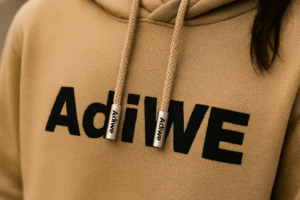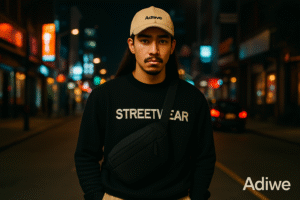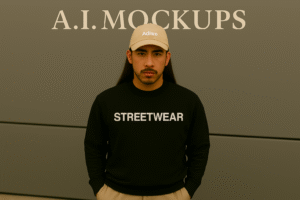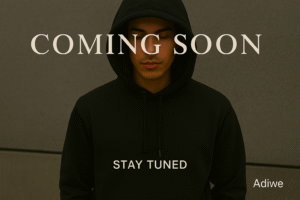Choosing fabrics for streetwear feels confusing? Wrong materials can ruin your designs and brand reputation. Let's explore top fabric choices for that perfect urban feel.
The best fabrics for custom streetwear include cotton (jersey, fleece, French terry), denim, nylon, and polyester blends. Quality, durability, comfort, and printability are key factors for standout streetwear that resonates with the culture.
That initial fabric choice is crucial, but it's just one piece of the puzzle. Streetwear is a whole vibe, built from specific materials, design philosophies, and cultural roots. As the owner of Adiwe, working with brands like Fifty Fifty from England, I've seen how these elements must align. Let's explore what truly makes standout streetwear.
What Is the Best Fabric to Make Clothes With?
Overwhelmed by endless fabric options for your clothing line? Picking incorrectly means wasted samples and poor garment quality. Let's pinpoint the most versatile and reliable choices.
"Best" depends on the garment, but cotton is highly versatile for its comfort, breathability, and ease of printing. For streetwear, heavyweight cottons like fleece and French terry are excellent for hoodies and sweats, offering both comfort and a premium feel.
!
When clients ask me this, especially those new to production, I always start by understanding the specific garment they envision. However, some fabrics are consistently popular for good reasons.
-
Cotton: The King of Comfort and Versatility
Cotton is a natural fiber. It is soft, breathable, and absorbent. This makes it very comfortable to wear against the skin. This comfort is essential for streetwear, which is often worn daily. At my factory, Adiwe, we work with many types of cotton.
- Cotton Jersey: This is the classic t-shirt fabric. It's usually lightweight, has a good stretch, and hangs well on the body. We can source jersey in various weights (GSM - grams per square meter) to achieve different drapes and levels of durability.
- Cotton Fleece: This is the go-to for hoodies and sweatpants. It has a soft, brushed inner surface that provides warmth and a cozy feel. My client, Fifty Fifty, often specifies high-GSM cotton fleece for their hoodies because they want that top-quality, substantial feel that their customers love.
- Cotton French Terry: This is similar to fleece, but the inside has loops instead of a brushed surface. It's generally a bit lighter than fleece and is great for items that can be worn in various seasons.
-
Other Notable Mentions:
While cotton is a champion, other fabrics play vital roles. Denim is a streetwear staple for jeans and jackets due to its toughness. Nylons and polyesters are key for outerwear, tracksuits, and athletic-inspired pieces, offering water resistance and durability. The "best" fabric truly aligns with the garment's purpose, desired aesthetic, and the quality your brand, like Adiwe, wants to deliver. We always guide our clients through these choices.
What Are the Elements of Streetwear Fashion?
Trying to define the core of streetwear fashion? Misunderstanding its elements leads to designs that don't resonate with the culture. Let's break down its key components.
Key elements of streetwear include comfort (loose fits, soft fabrics), graphic prints and logos (bold statements, brand identity), exclusivity (limited drops), and cultural influences (skate, hip-hop, art, sports). Authenticity is vital.
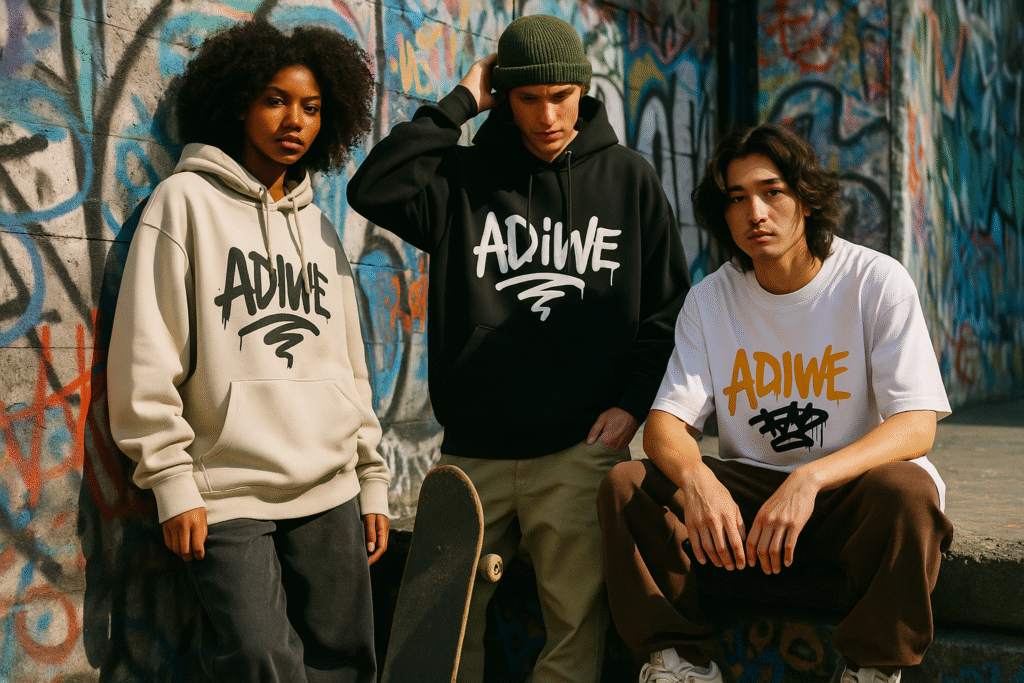
Streetwear is much more than just clothing items; it's a whole culture and a form of expression. As a manufacturer working with many trend brands, I see these core elements consistently appear in the designs they bring to us at Adiwe.
-
Comfort and Practicality Above All
Streetwear's origins are in practical, comfortable clothing. Think about skate culture, hip-hop, and other urban movements. This means silhouettes are often relaxed, sometimes oversized. Hoodies, joggers, comfortable t-shirts, and practical outerwear are staples. The fabrics we discussed, like soft cotton fleece or breathable jersey, directly support this need for comfort in everyday wear.
-
Graphics, Logos, and Storytelling
Bold graphics, unique logos, and impactful slogans are huge in streetwear. These aren't just decorations; they are ways for brands to tell a story, make a statement, or build a strong visual identity. For many of my clients, including KOLS and established clothing brands, the artwork is a critical part of their product. This is why our ability at Adiwe to perfectly reproduce complex designs and offer top-quality printing and embroidery is so important.
-
Exclusivity and "Hype"
Many successful streetwear brands use strategies like limited edition drops or special collaborations. This creates a sense of urgency and exclusivity, often called "hype." While my role as a factory owner is focused on producing the goods, I understand this market dynamic. We work closely with brands to meet their production timelines for these strategic releases.
-
Deep Cultural Roots
Streetwear is deeply connected to various subcultures. Skateboarding, hip-hop music and its surrounding culture, graffiti art, and even sports like basketball have all shaped what streetwear is today. Authentic designs often pay homage to these roots. Brands that understand and respect these influences tend to connect better with their audience. This authenticity is something that can't be faked.
What Are the Four Types of Streetwear?
Feeling lost in the diverse styles of streetwear? Not knowing the types can make it hard to focus your brand's aesthetic. Let's categorize the main streetwear vibes.
Four common types of streetwear are: Hypebeast (logo-driven, limited editions), Skate/Surf (functional, relaxed, graphic-heavy), Techwear (futuristic, utilitarian, performance fabrics), and High-Fashion Streetwear (designer takes, luxury materials, avant-garde).
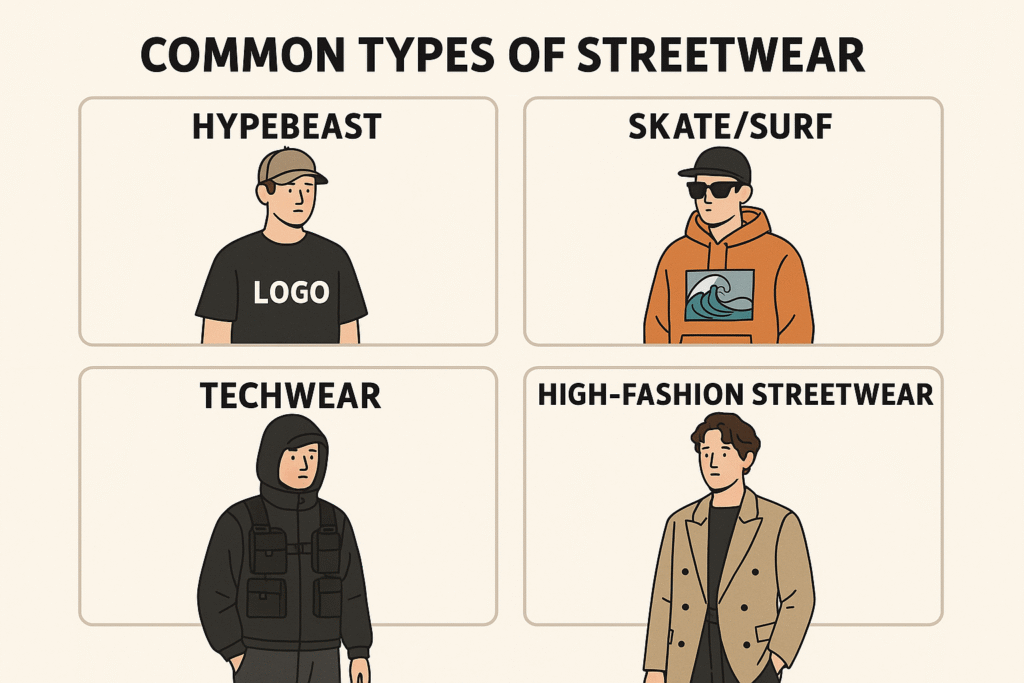
Streetwear is not just one single look. It's a wide field with many different styles. When I talk to potential clients, from new trend brands to established clothing lines, understanding which style they are aiming for helps my team at Adiwe tailor our production approach. Here’s a breakdown of some main categories:
-
Hypebeast / Logo-Centric
This style is heavily driven by recognizable logos and brand names. Think of brands where the logo itself is the main design feature. Limited edition items and high resale values are common here. For these products, the perceived value is very high, so the quality of the garment itself, including the fabric and the execution of the logo (print or embroidery), must be perfect.
-
Skate / Surf Inspired
This is the classic, original streetwear vibe. It’s all about comfortable, durable clothing that’s practical for an active lifestyle but also looks cool. Graphic t-shirts, hoodies, loose-fitting pants or shorts, and beanies are key items. The graphics often reflect skate or surf culture. Authenticity and a relaxed feel are important. Fifty Fifty's hoodies, while having a design focus, often lean into this comfort and quality aspect.
-
Techwear
This is a more modern, futuristic style. Techwear focuses on functionality, using advanced materials and innovative construction. Think waterproof jackets with lots of pockets, pants with articulated knees for movement, and often a darker, more minimalist color palette. Producing techwear requires specialized knowledge of performance fabrics and complex garment construction, which we are equipped for.
-
High-Fashion / Luxury Streetwear
This is where streetwear style meets the world of high fashion. Designer brands take streetwear shapes like hoodies or sneakers and create them with luxury materials and avant-garde design twists. It often plays with oversized silhouettes and reinterprets street culture through a high-fashion lens. This segment demands the absolute highest quality in materials and craftsmanship.
| Streetwear Type | Key Characteristics | Common Garments | Primary Fabric Focus |
|---|---|---|---|
| Hypebeast | Prominent logos, brand status, limited drops, collectibility | Logo hoodies, graphic tees, exclusive sneakers | Premium cottons, specialty prints/embroidery |
| Skate/Surf | Comfort, durability, relaxed fits, cultural graphics | Graphic t-shirts, hoodies, chino pants, board shorts | Cotton jersey, fleece, denim, canvas, corduroy |
| Techwear | Functionality, performance fabrics, utilitarian design, urban | Technical jackets, cargo pants, layered systems | Nylon, polyester, Gore-Tex, other performance textiles |
| High-Fashion Street | Designer interpretation, luxury materials, avant-garde shapes | Oversized coats, deconstructed hoodies, statement pants | Fine wools, silks, leathers, custom-developed fabrics |
Conclusion
Choosing the right fabrics and understanding streetwear's core elements and diverse types are vital for creating a successful brand. These insights help you build an authentic and appealing collection.

